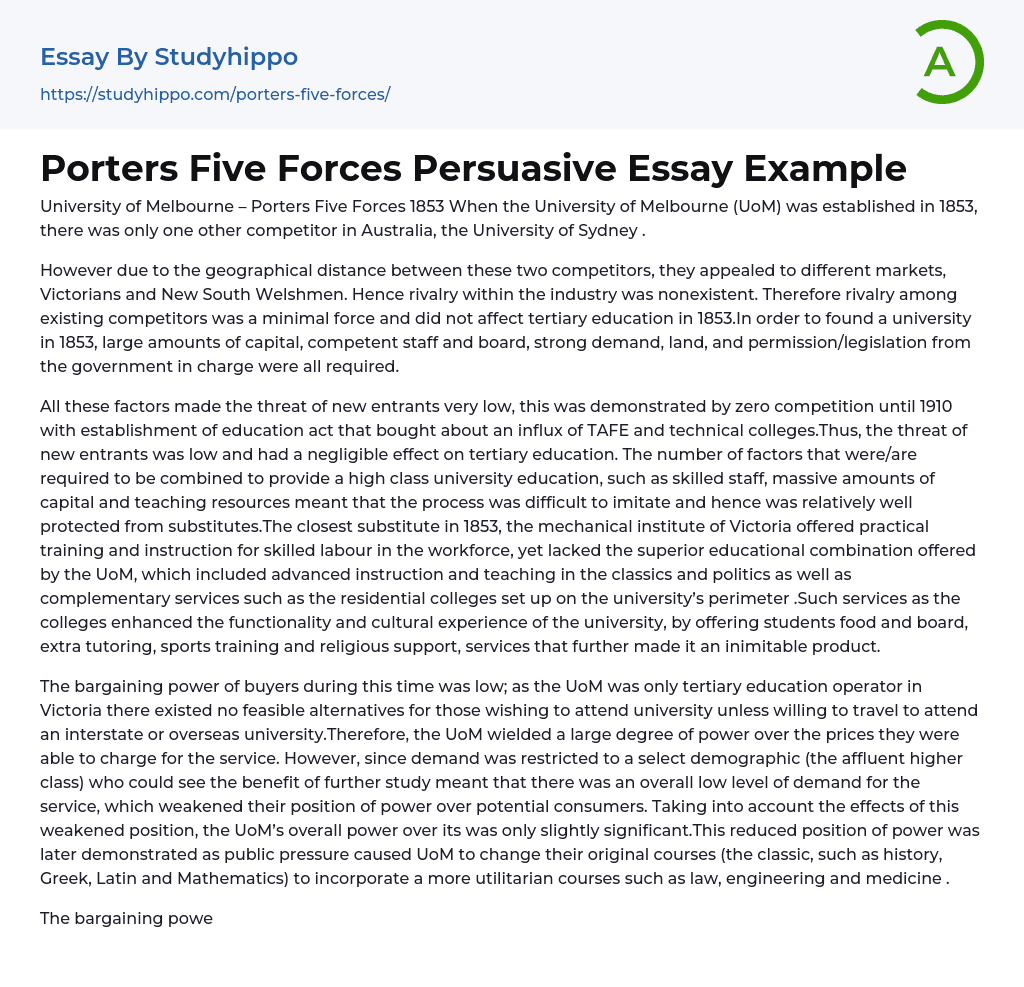The University of Melbourne (UoM) was founded in 1853 when there was just one other rival in Australia, the University of Sydney, which is known as Porters Five Forces.
Despite catering to different markets - Victorian and New South Welshmen - the geographical separation of these two competitors meant that there was no rivalry within the industry. As a result, existing competitors had minimal impact on tertiary education in 1853. To establish a university during this time required significant capital, competent staff and board, strong demand, available land, and approval from the governing body.
The low threat of new entrants to tertiary education was demonstrated by the absence of competition until the establishment of the education act in 1910, which brought about an influx of TAFE and technical colleges. The combination of factors required for a high-quality university education, including skilled
...staff, large amounts of capital, and teaching resources, made it difficult to imitate and thus well protected from substitutes. The closest substitute in 1853 was the mechanical institute of Victoria, which offered practical training for skilled labor but lacked the superior educational combination offered by the UoM, which included advanced instruction in classics and politics as well as complementary services such as residential colleges. These services enhanced the functionality and cultural experience of the university, providing students with food, board, extra tutoring, sports training, and religious support, further making it an inimitable product.
During this time, the bargaining power of buyers was reduced at the UoM, as there were no feasible alternatives for tertiary education in Victoria. If students wished to avoid traveling to attend an interstate or overseas university, the UoM held significant
power over the prices charged for its services. Despite this, demand for the service was limited to affluent members of the higher class who could appreciate the benefits of further study. This resulted in an overall low level of demand that weakened the UoM's position of power over potential consumers. As a result of this weakened position, the UoM's overall power was only slightly significant. Further evidence of this reduced power was demonstrated as public pressure led to changes in their course offerings, replacing classic courses such as history, Greek, Latin and Mathematics with more utilitarian courses such as law, engineering and medicine.
During 1853, the University of Melbourne faced high bargaining power from its suppliers. Skilled academics and providers of specialized academic items, such as scientific instruments, were crucial to the functioning of the university during this time. Due to the limited number of suppliers and the indispensability of these items, those who did supply them were able to exert a premium and wield a high level of power over the university. The lack of substitutes for these critical items further compounded the suppliers' power. (Source: "History of Melbourne," revised March, 2007, http://www.)The history web pages of both the University of Melbourne and Sydney University were accessed on August 22, 2008 and March 2008 respectively. The URLs for these pages are unimelb. edu. au/about/history/index. html and http://www.syd.The history of higher education in Australia can be explored at the website edu. au/about/profile/pub/history. shtml, accessed on August 22, 2008. Additionally, a formal report by G. Goozee titled "The development of TAFE in Australia" can be found at www.ncver.edu, with pages 11-14 containing relevant information.The
text can be unified as follows, keeping the and their contents:
au/vetsystem/publications/574.html;, accessed 22 August, 2008. • Macintyre, S. ; Selleck, R. J. W.
(2003) Melbourne University Press provides a brief account of the history of the University of Melbourne, while John Poynter and Carolyn Rasmussen (1996) also delve into this topic.
A work titled "A Place Apart" authored by The University of Melbourne chronicling decades of challenges has been published by Melbourne University Press.
- Academia essays
- Higher Education essays
- Language Learning essays
- Studying Business essays
- Education System essays
- Study essays
- First Day of School essays
- Scholarship essays
- Pedagogy essays
- Curriculum essays
- Coursework essays
- Studying Abroad essays
- Philosophy of Education essays
- Purpose of Education essays
- Brainstorming essays
- Educational Goals essays
- Importance Of College Education essays
- Brown V Board of Education essays
- The Importance Of Higher Education essays
- Online Education Vs Traditional Education essays
- Academic And Career Goals essays
- Academic Integrity essays
- Brown Vs Board Of Education essays
- Distance learning essays
- Technology in Education essays
- Vocabulary essays
- Writing Experience essays
- Importance of Education essays
- Early Childhood Education essays
- Academic Degree essays
- Academic Dishonesty essays
- School Uniform essays
- Academic writing essays
- Cheating essays
- Bachelor's Degree essays
- MBA essays
- College Life essays
- Grade essays
- Diploma essays
- Phonology essays
- Sentence essays
- Filipino Language essays
- Pragmatics essays
- Millennium Development Goals essays
- History Of Education essays
- Graduate School essays
- Middle School essays
- School essays
- Special Education essays
- University essays




